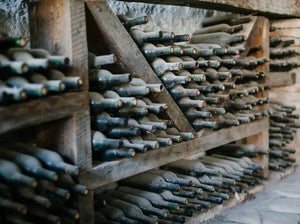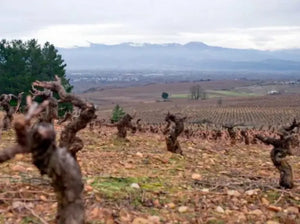Blog » Spain
-
Spain Value Star: 4 Monos GR10 Tinto
Collaborative efforts between friends have been a common thread within The New Spain wine scene. In the past, we've focused on the high-end, single-vineyard bottlings of Comando-G, but today's offering is the value play. 4 Monos models how delicacy and transparency can be a Spanish red's leading traits.
GR10 Tinto comes from three villages with granite-dominant vineyards and vines ranging from 30 to 85 years old. The blend is 85% Garnacha, 10% Cariñena, 3% Morenillo, and 2% Syrah. There's certainly a core of energy and an abundance of minerality, but these fresh fruit qualities take me back to tasting grape clusters picked off the vine. It's also 4 Mono's brilliant, non-interventionist approach in the cellar that gives GR10 such sophisticated texture and structure.
The Four Monkeys, as they call themselves, clearly share a passion for lively and fruit-forward wines. Javier Garcia, Laura Robles, David Velasco, and David Moreno met while hiking in the Sierra de Gredos mountain range, located 80 km east of Madrid. All had unique backgrounds related to wine, each bringing a different element of expertise to this project founded in 2009. -
Heaven Sent Albariño: Nanclares y PrietoLegendary U.S. importer José Pastor has been the gateway to many new Spanish discoveries, including Envínate and Luis Rodriguez. Alberto Nanclares and Silvia Prieto in Rias Baixas marked a massive shift in my understanding of descriptors like "crystalline" and "acid-driven" regarding Albariño and the Spanish white wine category as a whole.Like Vincent Dauvissat's Chablis, an element of clay in the soil (mixed with decomposed granite) gives these wines a gorgeous texture that stands out from the rest of the pack. Nanclares y Prieto produces a powerful and saturating style of Albariño still founded upon fresh citrus and orchard fruits, with a salty, long finish. These have become my Spanish white obsession over the last few years, and I take every single bottle offered from José.
"Alberto Nanclares": The flagship wine of the estate. A blend of eight east-facing parcels on decomposed granite and sandy loam. Aged in used French oak barrels.Soverribas: Vines up to 100 years old from three west-facing parcels on sandy, granitic soils with clay deposits. Fermented and aged in a 2200L neutral French oak barrel.O Son Das Pisadas: 100% Mencia from the ‘Eira Padín’ parcel in Rias Baixas. Vines are trained high in the espaldera method. Soil is sandy loam over granitic bedrock.Minato da Rana: 100-year-old Mencía and Garnacha vines on granite in Ribeira Sacra, supplemented by 10% Palomino and Godello. -
Consistent in Catalunya: Pardita Creus Natural Wines
Partida Creus was founded in 2001 by Massimo Marchiori and Antonella Gerona, well before the "natural wine movement" gained steam internationally. The duo formed what is now one of the most iconic and respected names in the category and has steadily pulled in more conventional wine drinkers to see this different lens on Catalunya. The duo were architects by trade living in Barcelona but yearned for a slower pace of life and an opportunity to connect with their native land. After acquiring their property dubbed “El Maiol” and discovering abandoned vines of the indigenous grape Sumoll, the idea to recoup the soil and restore the vineyard took hold.
Powered by the passion to make organic wine for themselves, friends, and eventually the natural wine-loving masses, their now renowned two-letter wine labels hit the market with the inaugural vintage 2007. Their house style is unfined, unfiltered, with precision and refreshing acidity. -
The Old Rioja Cellar: Private Selections from WineWiseWinter always marks a dramatic shift in the wines we begin to reach for. Many regions that have largely sat on the bench during the sweltering months have eagerly anticipated their call up to the plate. January also coincides with one of the very most exciting releases of the year––The Rioja Cellar.Hiram Simon's WineWise, the official California importer of Lopez de Heredia, visits private cellars each year in and around Rioja. There, he tastes and acquires aged wines from the deepest and most serious cellars in the region. I gave my order request last year based on his tastings, and today, these pristine Tempranillo-based Rioja gems are in stock and ready to ship.Over the last two years, the highlight of Hiram's selections, for me personally, is in these more relatively modestly priced wines. This is always such a rare opportunity to taste one of the world's most classic and age-worthy regions with simply perfect provenance. As mentioned, these wines have been aged in cellars in and around Rioja since their initial release.Note: Gran Reserva (sp.) is part of a nomenclature implemented in 1982. Before that, the Reserva wines were all non-vintage and denoted as 6º Año, in the case of Tondonia. Any wine called Cosecha is by nature the wine subsequently marketed as Gran Reserva.
Photo Credit: Julia Volk
-
Spanish Mic Drop: Raul Perez Atalier
It's hard to comprehend how one producer, like Raul Perez, can redefine the Spanish white wine category. His most monumental wine is Sketch, an Albariño sourced from a 0.5-hectare parcel of old vines in Rias Baixas, priced at $100-plus per bottle. It's worth its weight in gold, but upon release, rumors swirled that his other Albariño was going to be the proverbial mic drop moment for the variety.
Our go-to Atalier bottling, "A Cruz das Animas" comes from two parcels of Albariño vines in the Cambados area of the Salnés Valley, located in the southern portion of Spain's northwest tip. And today, we're adding "La Encrucijada" from Atalier's oldest and most sea-adjacent vines, which sees extended aging in barrel (About 14 months) on its fine lees before bottling. Raul's greatest influence is white Burgundy, and he takes every step possible to preserve Albariño's cut and delineation iwhile also pushing for maximum ripeness and flavor development.
The key steps are harvesting very late and then blocking malolactic fermentation, which allows for superb ripeness but eliminates the more viscous and creamy elements of Albariño that don't appeal to Raul. Aging is in older French foudre, which preserves tension and softens texture. Perez redefines what a mineral-driven Spanish white wine is capable of, showing the same depth and nuance I expect from Chablis and Côte de Beaune Chardonnay. Simply put, his Atalier over-delivers.
.svg?v=162776257677185172071724397232)







